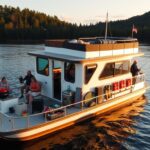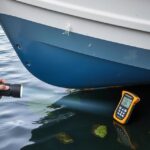Table of Contents
Do you wish to know how to stay safe on a houseboat trip? Yes, Houseboat safety is key for a fun and stress-free water vacation. As someone who loves houseboating, I know how important it is to be ready. I’ll share important tips to keep you and your family safe on your houseboat trip.
Houseboating is exciting, but it has its own challenges. You need to know about navigation, fire safety, and more. I’ll talk about safety checks, watching the weather, and what to do in emergencies. My aim is to help you be ready for anything on your houseboat adventure.
Key Takeaways
- Always wear life jackets when on deck or in rough waters
- Conduct daily safety inspections of your houseboat
- Familiarize yourself with basic navigation rules and local waterways
- Keep fire extinguishers easily accessible and know how to use them
- Monitor weather conditions and have an emergency plan in place
- Maintain working smoke and carbon monoxide detectors
- Practice safe anchoring and docking techniques
Essential Pre-Trip Safety Planning and Preparation
Planning a houseboat trip needs careful preparation for safety on the water. I start by focusing on key boat safety tips and houseboat security. This is key for marine emergency preparedness.
Required Safety Equipment Checklist
Before we set sail, I ensure we have all necessary safety gear. This includes:
- Life jackets for each passenger
- Fire extinguishers
- First aid kit
- Flares and distress signals
- Navigation lights
- Sound-producing device (horn or whistle)

Weather Monitoring and Trip Planning
I always check the weather forecast before and during the trip. Knowing wind patterns, storms, and water conditions is crucial for safe navigation. I plan my route carefully, noting safe harbors and potential hazards.
Emergency Contact Information Setup
Setting up emergency contacts is a critical step in my pre-trip preparation. I create a list of important numbers including:
- Coast Guard
- Local marine patrol
- Nearby marinas
- Emergency medical services
I share my trip plan with a trusted contact on shore, including expected departure and return times. This enhances my overall marine emergency preparedness, ensuring help can reach us quickly if needed.
SHORTCODE FOR NEWSLETTER:-
Understanding Basic Houseboat Navigation Rules
Navigating houseboats safely is key for a fun trip. I’ll cover important rules to help you avoid accidents and enjoy smooth sailing.
Knowing right-of-way rules is crucial. Smaller boats usually give way to bigger ones. When two boats meet head-on, both should turn right. The boat on the right gets the right-of-way when crossing paths.
Speed limits change by location. Always go slow near shorelines, docks, and other boats. This helps prevent accidents and damage to the environment.
Signaling correctly is important for safe travel. Use your horn to signal your plans:
- One short blast: Passing on your port (left) side
- Two short blasts: Passing on your starboard (right) side
- Three short blasts: Operating astern propulsion
- Five or more short blasts: Danger signal
At night, use navigation lights to show where you are and where you’re going. Red lights are on the left, green on the right, and white at the back and top.
| Navigation Light | Position | Visibility Range |
|---|---|---|
| Red | Port side | 2 nautical miles |
| Green | Starboard side | 2 nautical miles |
| White (stern) | Rear | 2 nautical miles |
| White (masthead) | Top | 3 nautical miles |
By sticking to these basic rules, you’ll greatly reduce the risk of accidents. This way, you can enjoy safe and enjoyable houseboat trips.
How to Stay Safe on a Houseboat Trip
Safety is key when you’re on a houseboat adventure. I’ve learned that to stay safe, you need to be careful every day. Here are some important tips to make your boat trip safe and fun.
Daily Safety Inspections
I always check the boat every morning. I look at the fuel, check for leaks, and make sure everything works. A quick walk-around can catch problems early.
Proper Life Jacket Usage
Life jackets are a must on a houseboat. I make sure there’s one for everyone and they’re easy to find. Kids should wear them all the time when they’re outside. The right life jacket is the one you’re wearing!
Safe Movement Around the Vessel
Moving safely on a houseboat is important to avoid accidents. Here’s how I do it:
- Use handrails when available
- Walk, don’t run
- Wear non-slip footwear
- Keep the deck clear of clutter
| Area | Safety Tip |
|---|---|
| Deck | Use non-slip mats |
| Stairs | Always use handrails |
| Kitchen | Secure items while moving |
Following these safety tips makes staying safe on a houseboat easy. It lets everyone relax and enjoy the water life.
Fire Prevention and Emergency Response
Fire safety is key for houseboat trips. I focus on preventing fires and being ready for emergencies. This makes our journey safe and fun.
Fire Extinguisher Locations and Usage
I check the location of fire extinguishers before we leave. They’re near exits, in the kitchen, and engine room. To use one, I remember the PASS technique:
- Pull the pin
- Aim at the base of the fire
- Squeeze the handle
- Sweep from side to side
Emergency Evacuation Procedures
We have a clear plan for leaving the boat quickly. We pick meeting spots and practice drills. If there’s a fire, we:
- Alert everyone
- Put on life jackets
- Use fire extinguishers if it’s safe
- Get out to our spots
- Call for help with the marine radio
Smoke Detector Maintenance
Working smoke detectors are crucial for catching fires early. I check them every month and change the batteries once a year. This simple step helps a lot with fire safety.
| Fire Safety Item | Location | Maintenance Frequency |
|---|---|---|
| Fire Extinguisher | Kitchen, Engine Room, Exits | Annual Inspection |
| Smoke Detector | Sleeping Areas, Living Spaces | Monthly Testing |
| Emergency Radio | Bridge or Main Living Area | Pre-Trip Check |
By sticking to these steps, we’re well-prepared for emergencies. This makes our houseboat trip safer and more fun.
Carbon Monoxide Safety Measures
Carbon monoxide is a big risk on houseboats. It’s colorless and odorless, making it deadly in closed areas. Knowing how to stay safe is key for a fun houseboat trip.
Make sure to install carbon monoxide detectors on your boat. Put them near where people sleep and check them often. Don’t forget to change the batteries when they run out. These steps can really help keep everyone safe.
Good air flow is important to avoid CO buildup. Always open windows, doors, and hatches when you can. Never use engines or generators inside. If you smell exhaust or feel dizzy, get outside right away.
“Carbon monoxide is known as the silent killer. Always be vigilant and take precautions to ensure your houseboat adventure stays safe and enjoyable.”
Teach everyone on the boat about CO dangers and signs. Symptoms like headaches, nausea, and dizziness are warning signs. If someone shows these signs, move them to fresh air and get help if it’s needed.
Keep your boat’s engines, generators, and exhaust systems in good shape. Have them checked by experts regularly. By following these tips, you can greatly reduce the risk of carbon monoxide on your boat. This makes your trip safer for everyone.
Anchoring and Docking Procedures
Learning how to anchor and dock your houseboat is very important. I’ll show you how to keep your boat safe in different situations.
Proper Anchor Selection and Setup
Choosing the right anchor is crucial. I suggest using a plow or fluke-style anchor. Also, make sure your anchor line is at least seven times the water depth.
Safe Docking Techniques
When you’re getting ready to dock, slow down and check the wind and current. Assign tasks to your crew, like handling lines. Use fenders to protect your boat from damage. Always approach at an angle, not straight on.
Night Anchoring Guidelines
At night, anchoring needs extra care. Use a spotlight to see around you and check for other boats. Drop your anchor early to give it time to set. Always turn on your anchor lights so others can see you.
- Check weather forecasts before anchoring
- Set up a watch rotation for overnight stays
- Use GPS to monitor your position throughout the night
By following these tips, you’ll have a safe and fun time on the water. Practice these steps to feel more confident with your houseboat.
Weather-Related Safety Protocols
Weather is very important for safety on the water. I always check the forecast before and during my trips. Here are some key boat safety tips for different weather conditions.
Storm Response Procedures
When a storm is coming, I quickly tie down loose items and close all hatches. Everyone must wear life jackets and stay inside. If it’s safe, I try to find a nearby harbor or sheltered spot.
Lightning Safety Guidelines
Lightning is a big danger on the water. I don’t use electrical things during thunderstorms. It’s important to stay low and away from metal. If I’m in open water, I drop anchor and wait for the storm to pass.
High Wind Navigation Tips
High winds need extra care. I slow down and keep a steady path. Keeping the bow into the wind helps me stay in control. I also make sure everyone is seated to avoid accidents.
| Weather Condition | Safety Measure |
|---|---|
| Storm | Secure loose items, wear life jackets |
| Lightning | Avoid electrical equipment, stay low |
| High Winds | Reduce speed, keep bow into wind |
By following these safety tips, I make sure my houseboat trips are safe and fun. Remember, being prepared is the best way to stay safe on the water.
Preventing Slip and Fall Accidents
Slips and falls are common on houseboats. Wet surfaces can make a fun trip dangerous. Let’s look at some tips to stay safe.
Wearing the right shoes is key. I suggest non-slip shoes with good grip. Flip-flops are not safe on a wet deck. Choose boat shoes or water shoes made for the sea.
Adding non-slip surfaces is also important. Textured mats or strips in busy areas help a lot. Focus on steps, walkways, and the swim platform.
“Safety doesn’t happen by accident. It’s a choice we make every day.”
Be extra careful when it’s wet. Walk slowly and hold onto railings. Ask everyone to do the same to avoid accidents.
| Area | Safety Measure | Importance |
|---|---|---|
| Deck | Non-slip mats | High |
| Stairs | Textured strips | Critical |
| Swim platform | Rubber coating | Essential |
Keeping the boat clean and dry is important. Always have towels and mops ready for spills. These steps can make our houseboat trips safe and fun.
Emergency Medical Preparedness
Being ready for emergencies is key for a safe houseboat trip. I always pack a detailed first aid kit and plan for medical emergencies before we sail.
First Aid Kit Essentials
A good first aid kit is crucial for minor injuries and illnesses on the boat. Here’s what I carry:
- Bandages and gauze
- Antiseptic wipes
- Pain relievers
- Antihistamines
- Tweezers and scissors
- Burn gel
- Seasickness medication
Medical Emergency Response Plans
I have a detailed plan for serious medical issues. I know the nearest emergency services, have a way to call for help, and pick a crew member for first aid.
Seasickness Prevention and Treatment
Preventing seasickness is key for a fun trip. Here’s how I stay prepared:
- Stay hydrated
- Eat light meals
- Focus on the horizon
- Use acupressure wristbands
- Take over-the-counter medication if needed

| Symptom | Treatment |
|---|---|
| Nausea | Ginger tea, crackers |
| Dizziness | Fresh air, lie down |
| Headache | Pain reliever, cold compress |
By focusing on emergency preparedness and seasickness prevention, I make sure our houseboat trips are safe and enjoyable for everyone.
Conclusion
I hope this guide has given you valuable insights on houseboat safety. Staying safe on a houseboat trip requires careful planning and constant awareness. From pre-trip preparations to daily safety checks, every step matters in ensuring a secure voyage.
Houseboat safety isn’t just about following rules. It’s about creating a culture of caution and responsibility on board. By mastering navigation basics, fire prevention, and weather safety, you’re setting the stage for an enjoyable trip.
As you embark on your houseboat adventure, keep these tips in mind. They’ll help you tackle unexpected situations with confidence. Safe travels on your houseboat journey!
FAQ
What essential safety equipment should I have on a houseboat?
I make sure my houseboat has life jackets for everyone. It also has fire extinguishers, smoke detectors, and carbon monoxide detectors. A first aid kit, navigation lights, and a sound-producing device are must-haves.
I also have a VHF radio for communication and emergency flares for signaling in distress.
How can I prevent carbon monoxide poisoning on a houseboat?
To avoid carbon monoxide poisoning, I install and test CO detectors regularly. I ensure good ventilation and avoid running engines in closed spaces. Never use gas stoves for heating.
I teach all passengers about CO poisoning symptoms. If they feel sick, they should move to fresh air right away.
What are the basic navigation rules for houseboats?
When I navigate, I follow the “rules of the road” for waterways. This means keeping a lookout, yielding to vessels on my starboard side, and passing port-to-port when meeting head-on. I also follow speed limits and use signals when needed.
How do I safely anchor a houseboat?
To anchor safely, I pick a protected area with enough depth and room to swing. I use an anchor that fits the boat and the bottom. I lower the anchor slowly, allowing 7:1 line to water depth.
After setting, I check landmarks to make sure the boat isn’t drifting.
What should I do in case of a fire on a houseboat?
In a fire, my first step is to keep everyone safe. I alert passengers, have them put on life jackets, and prepare to leave if needed. I try to put out small fires with the fire extinguisher.
If the fire grows, I get everyone off and call for help using the VHF radio.
How can I prevent slip and fall accidents on a houseboat?
To avoid slips and falls, I make sure everyone wears non-slip shoes. I keep the deck clean and dry. I install non-slip mats and ensure good lighting.
I advise using handrails, especially in rough water or at night.
What weather precautions should I take when houseboating?
I always check the weather forecast before and during my trip. If bad weather is coming, I head to a safe place. During storms, I keep everyone inside and wear life jackets.
I also have a plan for lightning safety, like avoiding metal objects and electrical equipment.
How can I prevent and treat seasickness on a houseboat?
To prevent seasickness, I suggest staying hydrated and getting fresh air. Focus on the horizon and avoid alcohol. Dramamine can help if taken before symptoms start.
If seasickness happens, I have the person lie down in a stable area. I offer small sips of water and light snacks to help their stomach.




Pingback: Houseboat Trip with Friends: A Complete Guide oceangrandeur.com
Pingback: Travel Insurance Tips for Houseboat Vacations oceangrandeur.com
Pingback: Exploring India's Kerala Backwaters by Houseboat oceangrandeur.com
Pingback: Best Houseboats for Adventure Seekers oceangrandeur.com
Pingback: Winter Storage Tips for Houseboats oceangrandeur.com